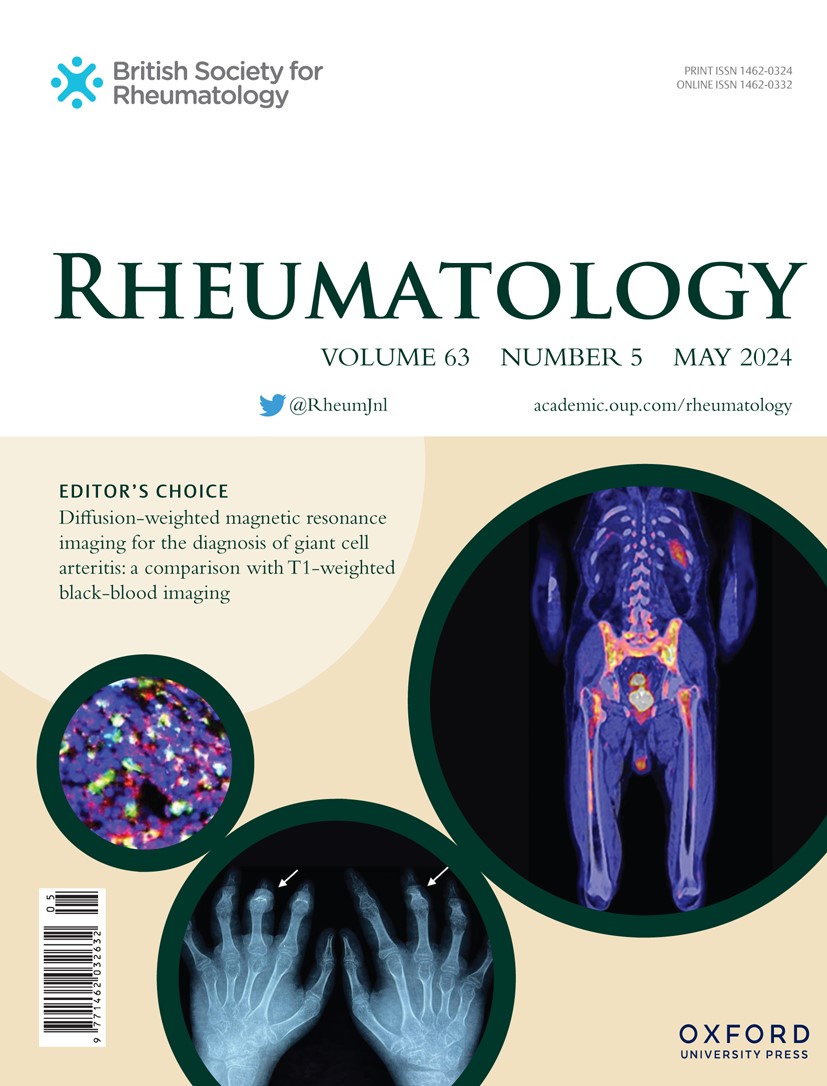Performance of the new PREVENT Score for indicating subclinical atherosclerosis in rheumatoid arthritis
IF 4.7
2区 医学
Q1 RHEUMATOLOGY
引用次数: 0
Abstract
Objectives Patients with rheumatoid arthritis (RA) are at increased risk of atherosclerotic cardiovascular disease (ASCVD), yet traditional 10-year CVD risk calculators—such as the 2013 Pooled Cohort Equations (PCE)—underperform in RA. Our objective was to determine the performance of the PCE vs the updated PREVENT algorithm in indicating presence of subclinical coronary and carotid atherosclerosis in RA. Methods Patients with RA without known CVD underwent chest CT to quantify a coronary artery calcium (CAC) score and carotid artery ultrasound to determine presence of carotid artery plaque. The PCE score and three 10-year PREVENT scores—Total CVD, ASCVD, and Total CVD with urine albumin-to-creatinine ratio (uACR)—were calculated; scores were compared in their performance to indicate CAC and presence of carotid plaque. Results The PCE score was significantly different from each of the PREVENT scores (p< 0.001). The PCE and the PREVENT scores were significantly associated with all levels of CAC and carotid plaque. In predicting CAC >0, the PREVENT ASCVD score area under the receiver operating characteristic curve (AUROC) was 0.723—lower than the PCE AUROC of 0.775 (p= 0.034). For carotid plaque, there was no difference in AUROC between the PCE and the PREVENT ASCVD, PREVENT Total CVD score, or PREVENT Total CVD + uACR score. Conclusion The newly updated PREVENT scores is not better than the prior PCE for indicating subclinical coronary and carotid atherosclerosis in RA. Because the PCE score already underperforms in RA patients, it is unlikely that the PREVENT algorithm will adequately predict CVD event risk in this population.新的预防评分在类风湿关节炎亚临床动脉粥样硬化中的表现
类风湿关节炎(RA)患者发生动脉粥样硬化性心血管疾病(ASCVD)的风险增加,但传统的10年心血管疾病风险计算方法(如2013年合并队列方程(PCE))在类风湿关节炎中的表现不佳。我们的目的是确定PCE与更新的prevention算法在指示RA患者存在亚临床冠状动脉和颈动脉粥样硬化方面的性能。方法无已知CVD的RA患者行胸部CT量化冠状动脉钙化(CAC)评分,颈动脉超声确定颈动脉斑块的存在。计算PCE评分和3个10年预防评分-总CVD、ASCVD和总CVD伴尿白蛋白与肌酐比值(uACR);比较它们的表现,以表明CAC和颈动脉斑块的存在。结果PCE评分与prevention评分差异有统计学意义(p<;0.001)。PCE和prevention评分与CAC和颈动脉斑块的所有水平显著相关。在预测CAC &;gt;0时,受试者工作特征曲线下的prevention ASCVD评分面积(AUROC)为0.723,低于PCE AUROC的0.775 (p= 0.034)。对于颈动脉斑块,PCE与PREVENT ASCVD、PREVENT总CVD评分或PREVENT总CVD + uACR评分之间的AUROC无差异。结论新更新的预防评分并不优于先前的PCE,用于指示RA的亚临床冠状动脉和颈动脉粥样硬化。由于PCE评分在类风湿性关节炎患者中表现不佳,因此预防算法不太可能充分预测该人群的心血管事件风险。
本文章由计算机程序翻译,如有差异,请以英文原文为准。
求助全文
约1分钟内获得全文
求助全文
来源期刊

Rheumatology
医学-风湿病学
CiteScore
9.40
自引率
7.30%
发文量
1091
审稿时长
2 months
期刊介绍:
Rheumatology strives to support research and discovery by publishing the highest quality original scientific papers with a focus on basic, clinical and translational research. The journal’s subject areas cover a wide range of paediatric and adult rheumatological conditions from an international perspective. It is an official journal of the British Society for Rheumatology, published by Oxford University Press.
Rheumatology publishes original articles, reviews, editorials, guidelines, concise reports, meta-analyses, original case reports, clinical vignettes, letters and matters arising from published material. The journal takes pride in serving the global rheumatology community, with a focus on high societal impact in the form of podcasts, videos and extended social media presence, and utilizing metrics such as Altmetric. Keep up to date by following the journal on Twitter @RheumJnl.
 求助内容:
求助内容: 应助结果提醒方式:
应助结果提醒方式:


